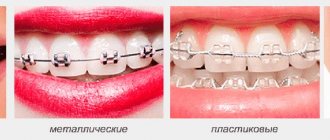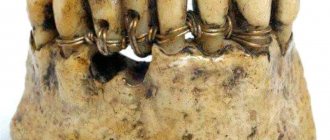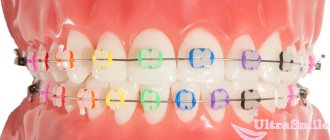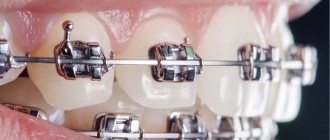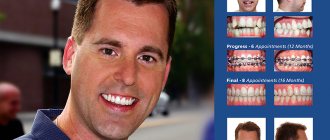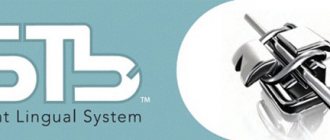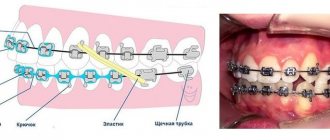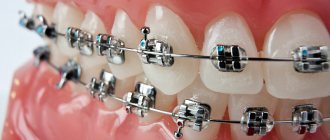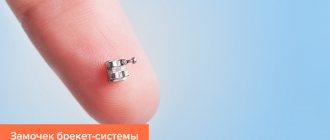Look at the smile in the photo. Do you notice anything strange? She’s kind of exhausted, tense... And it’s not surprising, because with braces you can’t smile much, because it hurts
.
After an orthodontist has placed braces on a patient, discomfort or even pain may occur. Is this normal? What to do if the pain does not go away or what should the patient do to reduce pain? And how can you avoid these rather unpleasant sensations? Let's figure it out.
It will be immediately important to note that sore teeth and gums after installing a brace system is, from the point of view of doctors, normal. It cannot be otherwise, because physical pressure begins to be exerted on the teeth, they begin to change their position - which, of course, at the first stage causes discomfort. Usually, most patients get used to these sensations; moreover, for the sake of a beautiful smile, one can endure temporary inconveniences.
And why, what pains will you go to to make your smile beautiful, right? )
So,
What are braces?
Braces, or rather brace systems, are dental structures for eliminating malocclusions and problems with incorrect position of teeth.
Alignment with orthodontic braces began to be practiced back in 1776 in France, but the heavy structures used then interfered with speech and extended beyond the mouth. More than a hundred years later, the device was radically improved in America. Today, the classic system looks different and consists of three main elements: ➢
braces - clasps that are attached to the teeth
➢
orthodontic arch
➢
fastenings (ligatures) for coupling the arch with the clasps
What are crooked teeth and what is the diagnosis?
Patients call their teeth crooked for different diagnoses. They can often be corrected with braces. What are called curved units in dentistry are divided into groups of anomalies:
- Position of individual teeth.
- Defects in the shape of the dentition.
- Bite problems.
If the position of the front teeth is incorrect, it is immediately noticeable, and the person often turns to the dentist. Teeth may tilt, rotate, or move in different directions. Very often there is a combined malocclusion of the central and lateral groups of teeth simultaneously in the lower and upper jaws.
Main types of braces
Previously, when it was necessary to straighten with braces, for many patients the stopping factor was the aesthetic side of the issue - the structures were made exclusively of metal and were fixed on the outside of the teeth. Now there are many types of orthodontic systems to suit every taste. The main differences between braces are the installation methods and materials of manufacture.
External and internal braces
A frequent question from patients is whether it is possible to place braces on crooked teeth without others noticing. Internal, or lingual, braces allow you not to worry about the aesthetic aspect. Unlike external ones, lingual systems are fixed on the back of the teeth and are completely invisible to others. True, the patient takes longer to get used to the lingual system. But it is not always suitable for people with allergies, since it is made of metal, which can provoke an allergic reaction.
Ligature and non-ligature braces
Ligature and non-ligature systems differ in the method of attachment to the arch. The first ones are attached using clamps (ligatures), while the second ones are devices of a more advanced level that do not require additional fastenings. Ligature-free braces allow you to adjust the position of the arch once every 2-3 months. However, many specialists prefer monthly treatment monitoring. Despite their more advanced structure, it is difficult to say that non-ligature dental braces are more effective than traditional ones.
What teeth are they placed on and what types of braces are there?
The classification of bracket systems is varied. The designs differ in materials, method of arch attachment, and location in the mouth. The following devices deserve interest:
- Vestibular – external braces for installation on the front (visible) surface of the teeth. When choosing this system, it is important to evaluate the characteristics of the material used, as it will determine the aesthetics and wearing comfort.
- Lingual - the structure is fixed on the lingual (inner) side of the dentition, which makes it invisible to others.
Based on the method of fastening the arch in braces, the following models are distinguished:
- ligature - fixation of elements among themselves is carried out using ligatures (rubber bands or small wires);
- non-ligating (self-ligating) – the power arc is tightly or loosely attached to the locking grooves of the plates.
When installing braces, the orthodontist will use the entire dentition - some of the plates will be visible in the smile area, the other part will be placed in an invisible area on the distant teeth. The material from which the braces are made will determine the aesthetics and will also affect the wearing comfort. Possible options:
- Metal ones are inexpensive and have been repeatedly tested in orthodontic treatment. They are capable of correcting even severe pathologies, but are not without drawbacks. Metal is more damaging to the mucous membrane when worn than other materials; it is unsightly and noticeable on the teeth.
- Ceramic – made to match the color of the enamel, they are practically invisible on the teeth. They cope well with correction, but are fragile and require care when worn. Due to the strength characteristics and the ability to be stained by food, certain restrictions are introduced into the patient’s eating habits.
- Sapphire - transparent and durable, do not change color from bright drinks and dishes. The most expensive of all designs, valued by teenagers and adults for their exceptional aesthetics.
- Plastic devices are short-term wearing devices, as they are unreliable, fragile and impractical.
Plaksina Margarita
For teenagers, I recommend the installation of combined braces - the visible part is made of an aesthetic material (sapphire, ceramics), and metal on the distant teeth. This combination gives optimal results and avoids the development of complexes in children.
Types of bracket systems
Some people don’t attach importance to the presence of a metal device in the mouth - back in the 90s, Cindy Crawford not only wore dental braces, but even starred in them in an advertising campaign for Pepsi Cola. For those who have chosen external orthodontic braces, but prefer not to advertise the treatment, there are other options.
Types of braces depending on material
- Plastic: the most budget braces - from 20,000 rubles. It is the plastic design that has become not just a device for dental treatment, but also an accessory that complements the image. Unfortunately, it also has many disadvantages: plastic is not the most durable material, in addition, such dental braces change color under the influence of coloring products.
- Metal: The most durable of all braces for straightening teeth, but they are not suitable for people with metal allergies. A steel system will cost 60,000 - 80,000 rubles, a titanium system - from 80,000 to 100,000 rubles. In terms of aesthetics, this is not the most advantageous design.
- Ceramic: highly aesthetic, matched to the color of the enamel, does not cause allergies, but is less durable than metal. In Moscow, the cost of ceramic braces is 40,000 - 70,000 rubles.
- Sapphire: the most aesthetic of all options. They look very impressive in the light, but if the patient’s teeth have a yellowish tint, you should carefully consider whether sapphire braces are needed, as they will stand out strongly. Also quite fragile. The cost of sapphire structures is 100,000 - 150,000 rubles.
Which braces are best to choose?
It is impossible to say unequivocally that this system is good and this one is not. Each has its own pros and cons. The patient’s choice is influenced not only by his desires and capabilities, but also by the doctor’s recommendations. Depending on the situation, only metal braces and no others may be prescribed - you should be prepared for such nuances.
Also, an important choice factor for the patient is the amount of time that will be spent on treatment, because this directly affects his possible limitations or inconveniences in his daily life.
A dentist specializing in this area will help you understand the advantages and disadvantages of each orthodontic system.
How do braces differ from each other?
| Type of braces | Materials | Differences | Price |
| Metal | metal alloy | reliable and cheap | from 50,000 rubles* |
| Ceramic | ceramics | the most inexpensive of aesthetic | from 70,000 rubles* |
| Sapphire | artificial sapphire | beautiful and relatively inexpensive | from 100,000 rubles* |
| Lingual | gold + metal | completely invisible | From 150,000 rubles* |
*Prices are indicative in Moscow and only for the bracket system.
What are braces?
A brace system is a non-removable orthopedic device consisting of clasps with grooves (braces), an arch that combines these clasps into a single mechanism, additional elements - elastics, ligatures, and an arch is passed through the grooves. The principle of operation lies in the ability of a metal arc to take its original shape. Straightening up, she pulls the locks behind her, pulling the teeth into the required position. The result is stabilized with fixed or removable retention devices.
Bracket systems differ in design - they are ligature, self-ligating, vestibular, lingual. They are made from a variety of materials: metal alloys (including gold), polycrystalline ceramics, synthetic sapphires. Devices made of metal have no equal in strength; the most aesthetically pleasing are ceramic and sapphire. When choosing which is better, aligners or braces for straightening teeth, you take into account not only the aesthetic side. The main thing to start from is the capabilities of the system in a particular case.
How do braces straighten teeth?
It is designed by nature that our teeth can change position - independently or under the influence of external forces. Thanks to this property, orthodontic treatment with braces becomes possible. Its principle is the following.
- Based on the patient’s clinical picture, the doctor plans a trajectory of movement for each tooth; one bracket is responsible for one dental unit.
- During the process of fixing the braces, the clasps are connected to each other by an arch with shape memory, which it tends to take over time.
- Under the influence of the arc, the dentition begins to take the desired position.
- During treatment, the archwire is replaced with a more rigid one to increase the impact.
Facial asymmetry
Some discrepancy in the size of the right and left halves of the face is normal. Not so long ago, the predominance of emotional and rational principles in a person was judged by the width of which side predominated. The skeletal anomaly underlying the formation of a crossbite significantly increases facial asymmetry, which deprives a person of attractiveness.
Asymmetry is revealed during external examination. During the dental examination, the doctor determines the presence of a displacement of one jaw relative to the other, which is accompanied by a change in the relative position of the dentition; one of the dentition may be expanded or, conversely, narrowed. Malocclusion leads to impaired diction, swallowing, and rapid abrasion of the enamel of the chewing surfaces of the teeth.
Indications and contraindications for installation
Problems that alignment with braces can help solve:
- crooked teeth due to improper growth
- displacement of the dentition as a result of the removal of dental units
- jaw development disorder
When there is crowding and gaps between teeth, braces are the optimal solution. In the latter case, it will not be possible to manage with orthodontic treatment alone; complex procedures with the participation of a surgeon will be required.
When are braces installed?
- Bite disorders of any nature or complexity;
- crowded teeth;
- disproportion of jaws (one is less developed);
- dental anomalies;
- incorrect position of the dental unit (curvature, rotation around an axis);
- removal of an unerupted tooth;
- upcoming prosthetics, implantation.
Treatment with ligature devices will take 2.5-3 years
, self-ligating -
1.5-2 years
. The duration of the adjustment depends on the clinical features and system model.
At what age are braces placed?
The mobility of teeth in the jawbone persists throughout a person’s life, therefore, the answer to the question “Can braces be placed on crooked teeth in adulthood?” - positive. However, correcting a child’s bite with braces is much easier.
You can begin treatment as early as 9 years of age, even if not all baby teeth have been replaced by permanent teeth. The most optimal age for installing braces is 12 - 13 years old, but even at 30, braces will show good results. It will just take more time.
Content:
- Who is recommended for teeth straightening with braces?
- Preparing to align rows with braces
- Installation of braces
- Wearing braces during teeth straightening
- Removing the leveling device
- How long to wear braces
- When alignment with braces is not possible
How do braces straighten teeth? They do not do this by themselves, since in reality they play only a secondary role. After all, the term “braces” hides tiny locks that are responsible for holding the metal arch. It is the latter that does all the leveling work - moves the curved units and forces them to take the correct positions. But it just so happened that the entire orthodontic structure was named after the miniature locks.
Braces for crowns, veneers, implants
Crowns are not a contraindication to orthodontic treatment. The best option for installing braces on crowns is a metal system. It will provide reliable adhesion to the artificial material of the prosthesis. If you need to install a brace system on the teeth that serve as support for the bridge, the doctor will simply remove the prosthesis and put temporary plastic crowns on the patient for the period of treatment.
As for veneers, if they are already on the teeth, this will not be a contraindication to installing a brace system. However, it is still better not to install veneers before braces, especially taking into account that an incorrect bite is, in principle, a contraindication to veneering.
With an implant, it is already more difficult to correct the bite with braces - the artificial root sits firmly in the bone and is not able to move except upward. If possible, it is better to correct the curvature of the dentition before installing an artificial root. However, if implants are already in place, orthodontic treatment can still be planned and successfully carried out.
How different are modern braces?
Different braces will make a perfect smile when the patient has very crooked teeth.
Fixed orthodontic appliances can be selected for everyone:
- Budget metal braces are decorative and ergonomic. Their shape eliminates trauma to the mucous membrane. A durable, effective option.
- Ceramic overlays are invisible, but they are more expensive and take longer to wear.
- Elegant sapphire options will become an original decoration and at the same time correct the bite.
- Technological innovative self-adjusting braces require a minimum number of visits to the orthodontist.
Crooked teeth without braces can be corrected using aligners, but fixed systems (braces) are still in demand and universal.
To ensure that formerly crooked teeth remain straight after removing braces or aligners and that your smile is pleasing, special designs are used - retention guards or retainers. After removing the systems, the doctor determines which option will preserve the effect of orthodontic treatment forever. The duration of the bite stabilization stage is individual in each case and is determined only by the attending physician.
Braces will help correct malocclusions of varying severity; the duration of wearing them is from a year in adolescence to three years in adults with severe pathologies. Getting used to the braces system varies individually - some patients stop noticing the installed overlays and arches after a couple of weeks, while others will need a month or more.
Just make an appointment with me and we will find the best way to solve your problem. The result of treatment often surprises even skeptics: crooked teeth before and after braces are a striking contrast. After treatment, the dentition becomes smooth and aesthetically presentable.
Braces for extracted teeth
It is possible to install an orthodontic structure in the absence of one or more teeth, but it depends on the specific clinical picture. For example, it is quite possible to straighten a slight curvature in the frontal zone, even if there are no molars in the row. But is it possible to use braces to close a void when supporting teeth are missing? In this case, installing a system makes sense only if we are talking about 6, 7 and 8 teeth. If the figure eight (wisdom tooth) is missing, movement is impossible, since the chewing teeth will not be enough for full functioning.
When are aligners installed?
- Trema, diastema;
- crowding of teeth (up to 6 mm);
- shortening or lengthening of the incisors (vertical anomalies of occlusion);
- rotation (wrong position) of the dental unit;
- the tooth deviates forward and backward;
- upcoming prosthetics or implantation.
The duration of treatment with aligners depends on the severity of the disorder. The course of correction can take from 8 months to 2 years or more. Each design has an individually specified trajectory of the action of weak forces on the dental units. One device displaces an abnormally located tooth by 0.2-0.3 mm. How many correctors are required for a set depends on the situation - the simpler the problem, the fewer aligners are needed.
The first pair of devices corresponds to the initial clinical picture; each subsequent pair includes adjustments to change the position of the teeth. The last pair displays the treatment result.
Braces for one jaw and several teeth
If the patient is concerned about the curvature of, for example, only the upper teeth, fair questions arise. For example, why do you need braces on two rows of teeth? And do they put braces on one jaw? Installing only upper braces or only lower braces is indeed possible in the absence of global problems. It is important that the treatment gives an effective result without affecting the function of the jaw.
If a patient has several crooked teeth in one area, the doctor may suggest partial dental braces. They are installed on a specific area of the dentition for about six months.
Why do children and adults have crooked teeth?
To the question “ Why do teeth grow crooked?” “There is no clear answer. There are several factors that lead to such problems, namely:
- Genetics. About 15-20% of cases of crooked teeth are associated with hereditary factors.
- Features of nutrition and feeding in the early period of growth. Thanks to breastfeeding and proper nutrition, the child trains the jaw muscles and forms the correct position and size of the gums. When he does not have such training, the muscles remain weak.
- Chronic diseases of the nasopharynx. They lead to constant mouth breathing, which negatively affects the teeth.
- Early loss of baby teeth, which causes the main ones to grow outside the dentition and become crooked.
- Bad habits, especially in young children. Sucking a pacifier, sleeping with a finger in your mouth, and the habit of biting your nails have an extremely negative impact on soft bones. Adults are affected by the habit of chewing pencils and pens - this usually bends the front incisors.
- Loss of one or more elements of the dentition. It especially affects the adult bite, which changes slowly. the curvature of the teeth will not be visually noticeable, but will still have a negative impact on the bite.
- The eruption of wisdom teeth can also disrupt the position of one or more molars and incisors. Lack of space in the jaw leads to crooked teeth and then crooked teeth.
The causes of crooked teeth can also be individual, for example, various genetic diseases often contribute to this. Your doctor will help you determine the real basis of the problem.
Contraindications for installing braces
The installation of braces on teeth can be hampered by relative and absolute contraindications.
Relative contraindications to braces can be eliminated. These include:
- low level of hygiene
- caries
- allergy to materials contained in braces
- periodontitis, periodontal disease
- bruxism
Absolute contraindications are serious health problems that make orthodontic treatment impossible. These include:
- oncological diseases
- epilepsy
- psychiatric disorders
- pathology of bone tissue
- alcohol and drug addiction
- venereal diseases
- blood diseases
- tuberculosis
- diseases of the immune and endocrine systems
Preparing to align rows with braces
Before installing braces, the doctor makes sure that the gums and teeth are in satisfactory condition.
If there is caries, pulpitis, gingivitis or any other dental disease, it must be treated. After installing metal arches, it is much more difficult to combat the symptoms of oral diseases. Also during the preparatory stage:
- radiography;
- taking impressions of both jaws;
- articulator examination.
Considering that each clinical case is unique, the patient may be prescribed consultations with a surgeon, orthopedist, or implantologist.
Can I wear braces during pregnancy?
During pregnancy, women's dental tissue becomes more fragile, and there is a risk of damage to it by orthodontic construction. Can braces be installed during this period? Yes, but ideally it is better to have orthodontic treatment before or after pregnancy. If you already have braces on your teeth, you should definitely inform the orthodontist about the changes in your body. The doctor will prescribe a detailed diagnosis and decide whether braces and pregnancy are compatible.
If everything is in order, treatment with dental braces can be continued as usual. If the effectiveness of orthodontic treatment is questioned, the specialist will recommend removing the system and using retainers until the process can be resumed.
Result of wearing: before and after photos
The effect of wearing an orthodontic system is noticeable already in the first two months - gross violations are corrected. Next, the position of the teeth and roots is normalized. By about the eighth month, the entire dentition can be corrected with braces; the next stage begins—correction of the bite with braces. During the final stage, the teeth are “worked out” in detail so that they fit together perfectly.
The course of treatment does not end with removing braces. Next, the doctor uses special structures to stabilize teeth after braces - retainers. The device is installed on the inner side of the dentition for 2 - 4 years. The duration depends on the age of the patient (the younger he is, the shorter the period of wearing retainers) and the severity of the anomaly.
In some cases, orthodontic systems have a positive effect on more than just the position of teeth. After braces, the face becomes more toned and the cheekbones become more pronounced. While wearing the structure, other muscles begin to work, emphasizing what was not noticeable before.
Underdevelopment of the chin, drooping corners of the lips
The formation of a distal bite is based on the discrepancy between the sizes of the upper and lower jaws. In this case, the lower one turns out to be noticeably shorter. The lower dentition is located posterior to the upper, which often leads to disruption of the closure of the incisors and canines. With a pronounced degree of defect, a so-called traumatic bite is formed, in which the incisors, without contact with their antagonists, rest against the gum mucosa and damage it.
The patient develops a so-called “bird profile”, in which the nose is the most protruding point of the face, and the chin is significantly slanted posteriorly. The lips are usually thin, the lower lip is sunken, and the mouth is always slightly open. The tone of the orbicularis oris muscle is reduced, which is manifested by drooping of the corners of the mouth. Excess soft tissue in the lower third of the face leads to the formation of a double chin, which is especially pronounced in obese patients.
The distal (posterior to normal) position of the lower jaw blocks the airway. And since a person needs to breathe, a complex of compensatory changes is formed at the level of posture. In order to clear the airways, a person stretches his head and neck forward. In order to maintain balance, the back bends in the thoracic region (hunched), the deflection in the lumbar spine increases, which causes the stomach to bulge forward. The position of the pelvis and feet changes.
People who are accustomed to the arrangement of their teeth on the jaw often see only the external manifestations of the problem (double chin and thin lips). Consequently, they solve the problem by eliminating its external manifestations: they resort to liposuction of the chin area, and inject fillers into the lips. In this case, a much more rational solution is to correct the position of the teeth on the jaws. In young patients, braces can correct jaw growth. In adults, severe forms of distal occlusion are eliminated by orthognathic surgery.
Teeth after braces
Many patients fear the negative consequences of braces. It is known that dental braces complicate oral hygiene procedures. However, following the doctor’s instructions for dental care during the treatment period will help avoid exposure to carious bacteria. If caries does appear, in most cases the specialist will be able to carry out treatment without disturbing the braces.
When removing sapphire or ceramic braces, damage to the enamel is possible - during the procedure they can crumble, which significantly complicates the orthodontist’s work. If damage occurs, the defect can be easily corrected with a small restoration.
What will help you cope with pain?
If you follow all the doctor's recommendations and properly care for your teeth and braces, pain may not occur at all, only some discomfort.
If the pain does not go away, then it is worth checking how the braces are installed; perhaps some mistakes were made that only a doctor will correct.
What other recommendations might there be for patients experiencing pain in braces?
- Dietary restrictions - switching to liquid and pureed foods. - How do you like this option?
- Treatment of braces with dental wax.
- Take painkillers only as prescribed by a doctor!
Diet restrictions
If you have braces, be prepared to change your diet and avoid foods that are hard, fibrous, or too hot or cold. Because this can break your braces, damage your teeth, or increase pain.
After installing the system, you should wait at least one hour before you can eat liquid or soft food. Soups, pureed porridge and even baby food are the basis of your diet during bite correction. And, by the way, you will have to brush your teeth very, very carefully, since food will constantly get stuck there, forming plaque:
Special wax
In pharmacies you can buy orthodontic wax, which is applied to braces and helps reduce pain from friction and pressure of the device on the mucous membranes and teeth.
Taking painkillers
Any medications, even the seemingly safest ones, should be used only after consultation with a specialist and after carefully reading the instructions, contraindications and side effects of these medications. By mindlessly taking any medications, you can only seriously harm yourself, always remember this!
For irritation of the mucous membrane, rinsing with chamomile decoction helps a lot. Of course, with one “but” - if you are not allergic to it.
CONCLUSION
: In case of any incomprehensible sensations, we recommend that you contact your doctor so as not to miss serious points during treatment.
We still have one important question, which we promised to answer at the very beginning of the article, here it is:
How to fix crooked teeth without braces?
Today, dentistry offers several alternative solutions that allow you to straighten teeth without braces:
- Restoration: correction of defects in the dental crown using composite materials. Provides quick results at an affordable price, but will last about five years, and the color of the material will change over time.
- Veneering: fixation of plates on teeth that are almost indistinguishable from natural enamel. The method is used instead of braces for small curvatures or large gaps and is not suitable if the patient has complex dental curvature or malocclusion.
- Installation of removable braces. Essentially, these are orthodontic structures that do not need to be worn constantly. However, calling them braces is not entirely correct; these are completely different systems.
Some statistics
Specialized medical publications contain different statistics regarding the prevalence of malocclusions. However, they all agree that approximately every second dental patient, regardless of age, has teeth that grow incorrectly. In third place in terms of frequency of occurrence is crossbite. The second place is occupied by mesial and distal bites. Combined anomalies are in the lead.
Each type of occlusion disorder is characterized by its own external manifestations, which, as a rule, do not decorate a person. Correction of these manifestations goes in parallel with the correction of the bite and does not require any additional effort on the part of the patient or doctor.
Are there removable dental braces?
Removable orthodontic systems are divided into trainers, plates and aligners. However, only the latter can be considered an alternative to braces.
Aligners are special aligners made of plastic material that are invisible to others. They are able to quickly and comfortably correct almost any dental defect. The aligners are removed when eating and brushing your teeth, which is very convenient. The Invisalign® system is considered the best today - it allows you to cope with defects that previously could not be straightened without braces. The design is made individually for each patient, so its cost is quite high and amounts to about 250,000 rubles.
Despite the many positive qualities of removable systems, the patient should make the decision about whether to install braces or use other correction methods only together with the attending physician.
Aligners: what are these devices?
Aligners are transparent orthodontic trays made of thermoplastic polymer composite. The difference between braces and aligners is that the pressure on the dental units is not exerted by clasps connected by an arc, but by special activators inside the device, which set the impulse to shift the dental unit. To achieve the desired results, a set of correctors is made of different thicknesses, shapes, and sizes.
Each pair is created taking into account the predicted trajectory of displacement of the dental unit to a given position. The aligners change sequentially from larger to smaller sizes (every 2 weeks). All aligners in the set are numbered, so the patient knows exactly which system to use at a certain period. Wear the corrective device for 20-22 hours
per day, every day, removing only for food and hygiene care.
Those who want to choose aligners instead of braces need to think carefully about how responsibly they treat treatment. Corrective devices often cause discomfort and pain, especially when changing the arch or cap. And if it is impossible to remove the bracket system and you have to endure adaptation, then the aligners can be removed at any time or “forgot” to put them on. This increases the correction time, and often reduces treatment to zero. Therefore, aligners are suitable only for patients who are truly motivated to achieve results. For those whose self-discipline is lacking, it is better to choose braces.
Do's and don'ts when straightening teeth with braces
Orthodontic treatment is a long and responsible process. At home, braces require compliance with a number of rules.
- Hard and sticky foods should be excluded from your diet to avoid damaging your dental braces or getting food stuck in them.
- Sudden changes in temperature in the oral cavity should not be allowed (that is, ice cream should not be washed down with hot tea). This affects the elasticity of the orthodontic arch and can lead to the clasp coming off.
- To prevent ceramic or plastic braces on your teeth from staining, you should avoid coffee, jam, wine and drinks with dyes. Smoking also causes the system to change color.
- The oral hygiene procedure should be carried out using an irrigator, floss (dental floss) and a special brush with V-shaped bristles. Oral care is necessary after every meal.
- If the braces are loose or come off, there is no need to worry - just consult a doctor, and he will easily and quickly correct the situation.
At first, after you start correcting your teeth with braces, all these restrictions may seem quite burdensome and make you think: was it worth getting braces? However, the patient gets used to them very quickly. In addition, the result of the treatment definitely justifies all these not so pleasant nuances.
Important!
Is it possible to do an MRI with braces? If a patient with an orthodontic device is undergoing an MRI of the brain or jaw, the doctor should be informed about the presence of the system. Metal braces can distort diagnostic results. However, undergoing an MRI in braces does not pose any danger to the body.
Should a malocclusion be corrected?
People, regardless of age, rarely think about the possible consequences of malocclusion on health, given that careless chewing of food harms the digestive system, poor posture leads to impaired coordination of movements, and causes degenerative processes in various parts of the spine. If so, let’s focus on the aesthetic component of orthodontic treatment.
Orthodontists are able to diagnose malocclusion based on external signs, without looking into the patient’s mouth. Most people also note signs indicating the presence of skeletal abnormalities leading to the formation of malocclusions. Another thing is that rarely does anyone evaluate these signs from a medical point of view; more often the person is simply considered ugly. And if a person also has a repulsive smile with crooked yellow teeth, then interpersonal communication can be significantly impaired.
Correction of malocclusions must be corrected in patients of all ages. Parents should not put off a visit to the orthodontist in the hope that “the child will outgrow it.” Adults who did not receive orthodontic treatment in childhood will benefit from wearing braces or aligners, as they will save teeth from abrasion, improve diction, and normalize nasal breathing. And a perfect smile never hurt anyone!
Photos before and after
It is impossible to create a truly Hollywood smile without straightening your teeth and correcting your bite. Therefore, if a patient has orthodontic problems, braces are included in the mandatory treatment plan. Incorrect bite and crooked teeth are one of the main contraindications for the installation of aesthetic restorations. If you ignore orthodontic treatment and proceed straight to veneering, the veneers simply will not stick to the teeth. This fact is confirmed by personal example by many celebrities who, for the sake of a perfect smile, put braces on their teeth.
Tom Cruise decided to fix his teeth with braces only after 40 years.
After the breakup of the Spice Girls, Melanie Jane Chisholm had to seriously work on her image, and, above all, straighten her teeth.
Cristiano Ronaldo was not always handsome, as his impeccable smile might lead you to believe. According to rumors, he spent more than a million euros on teeth straightening and other procedures.
How can you avoid pain with braces?
ANSWER: Very simple - aligners. A - not braces. This should be your normal choice for correcting your bite. Aligners have long proven to everyone - both doctors and patients - that they have a huge number of advantages over braces.
And with aligners, you don’t need to be afraid of pain for the simple reason that there is NO pain there.
Price for braces in Moscow
As a rule, the cost of braces in Moscow is formed from the price of the system itself, as well as the total costs of installation and further treatment. The cheapest braces are, of course, metal. Their price starts from 50,000 rubles. Relatively inexpensive ceramic systems that cost about 75,000 rubles. The cost of a sapphire bracket system starts from 85,000 rubles. You need to be careful here, as ceramics are sometimes passed off as sapphire. The most expensive will be lingual systems, especially if they are made to order, their approximate price starts from 100,000 - 150,000 rubles. When figuring out the cost, be sure to ask what is included and what services will need to be paid additionally. It happens that the initially low price of braces increases significantly during the treatment process. However, when choosing an orthodontist and a braces system, you should not focus solely on cheaper or more expensive; remember that poor-quality orthodontic treatment is fraught with a lack of results and the occurrence of a number of complications.
| A country | Manufacturer | Manufacturing materials | Price |
USA | 3M Unitek | Metal braces | from 25,000 rubles |
| Ceramic braces | from 70,000 rubles | ||
| Sapphire braces | from 80,000 rubles | ||
| Ormco | Metal braces | from 20,000 rubles | |
| Ceramic braces | from 45,000 rubles | ||
| Sapphire braces | from 50,000 rubles | ||
| American Orthodontics | Metal braces | from 40,000 rubles | |
| Ceramic braces | from 70,000 rubles | ||
| Sapphire braces | from 50,000 rubles | ||
| Ortho Technology | Metal braces | from 15,000 rubles | |
| Ceramic braces | from 35,000 rubles | ||
| Sapphire braces | from 40,000 rubles | ||
| The Dentsply GAC | Metal braces | from 20,000 rubles | |
| Ceramic braces | from 30,000 rubles | ||
Germany | TOP-Service für Lingualtechnik GmbH | Gold-platinum alloy braces (lingual only) | from 175,000 rubles |
| Forestadent | Metal braces | from 30,000 rubles | |
| Ceramic braces | from 60,000 rubles | ||
| Sapphire braces | from 90,000 rubles | ||
Korea | HT Corporation | Metal braces | from 20,000 rubles |
| Sapphire braces | from 30,000 rubles | ||
Italy | SIA Orthodontic | Metal braces | from 20,000 rubles |
| Ceramic braces | from 25,000 rubles | ||
Other varieties
One of the solutions to the problem of correcting malocclusion in children is the invention of colored or shaped “braces.” In fact, such systems have colored ligatures, and not the braces themselves, and in general an interesting effect is created.
Children and teenagers are often embarrassed to wear classic corrective braces, and a colored or shaped version can greatly simplify this procedure. As a result, such “braces” become a detail of the image, emphasizing individuality. In addition, the period of adaptation to wearing the structure, purely psychologically, passes in an easier form.
Curly braces
There is no point in talking about curly braces as a special type: these are ordinary systems equipped with ligatures of a unique shape. Children and teenagers prefer ligatures in the shape of stars or hearts. For parents, this often becomes the only effective way to involve the child in the treatment process, especially since sometimes it stretches over several months or longer periods.
Colored "braces"
Colored ligatures of colored “bracket systems” do not have any design features; they are designed to perform the same functions as ordinary conventional braces. The only additional role of these structures is to eliminate psychological barriers that prevent you from deciding to correct bite defects.
The color of the corrective system changes either through the use of ligatures of different colors, or plastic ligatures of the desired shade are placed. This is especially true for children, teenagers and adults who want to emphasize their creativity.
